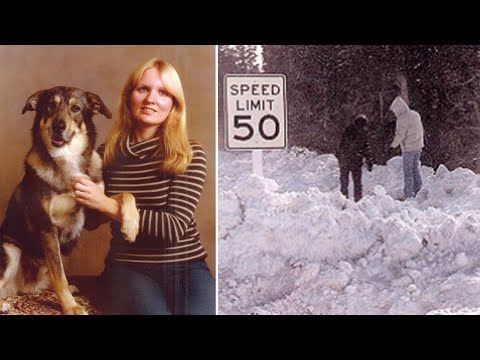5 Decades Old Cold Cases Solved In 2021

Hello everyone! In this video, we are going to check 5 decades-old cold cases that were solved in 2021. Welcome to Mysterious 5 ! The first case on our list is Annette Schnee and Bobbie Jo Oberholtzer In 1982, in Breckenridge, Colorado, two lifeless bodies of two different women were discovered. The crime scenes were miles from one another and the bodies were found six months apart. And yet, police believed that both women were killed on the same night, by the same man. The only thing connecting them? Orange socks.
On January 6, 1982, Bobbie Jo Oberholtzer, 29 years old, left home at 7.15 am. Her day had begun as usual and she hitchhiked to work. Jeff Oberholtzer was Bobbie’s husband. He ran an appliance repair business, and she worked
as a receptionist. They had been married for four-and-a-half years at the time of Bobbie’s death, and they lived in Alma, fourteen miles away from where her body was eventually found. At 6.20 pm Jeff got a call from Bobbie saying she was having drinks with friends after work. He asked her if she wanted him to pick her up, but she told him that she would get a ride home. Jeff made dinner and waited for Bobbie to come home. At some point, he fell asleep. He woke
up around midnight and discovered that his wife had not returned. Jeff drove into Breckenridge to look for Bobbie, and her friends told him she had left the bar around 7.30 pm; they assumed she had gotten a ride home. When Jeff reported to police that Bobbie was missing, they told him it was too early to file a report. Finally, he drove back home to wait for her wife. The next morning, a farmer who lived 30 miles outside Breckenridge found Bobbie’s driver’s license on his property. When Jeff and two friends were on their way to pick her up, they made a disturbing discovery – something blue in a snow-covered field. It was her
backpack, which she always had with her. Next to the backpack was one of Bobbie’s gloves, spattered with blood, and several bloody tissues. Jeff’s friends helped him organize a search. Two hours later, they found Bobbie’s lifeless body more than fifteen miles from where her backpack was discovered. She had been shot twice. Her house keys were found at the scene. At the crime scene, police found three intriguing clues; the only footprints near the body were from Bobbie; a plastic cord was tied around one of her wrists; a single orange sock was found nearby. The same day Bobbie Jo’s body was found, another woman, Annette Schnee, 21 years old, was reported missing. Annette was a cocktail
waitress in Frisco, Colorado, and like Bobbie, often hitchhiked to and from work. Because of the similarities, both cases were immediately connected by the police. Investigators questioned Jeff about Annette. At first, he denied knowing her, however, after seeing her picture on the news, he recalled meeting her once. Jeff claimed he had once picked up Annette when she was hitchhiking and he had given her his business card but had never seen or heard from her since that day. He also denied any involvement in her disappearance or Bobbie’s death. On July 3, 1982,
six months after her disappearance and 13 miles away from where Bobbie Jo’s body had been found, Annette’s body was discovered. Police were shocked with the discovery that she was wearing the match for the orange sock. Jeff’s business card was found inside her wallet. The prime suspect immediately became Jeff Oberholtzer. Authorities tried to put together a scenario for what might have happened on the night of January 6. Annette Schnee was last seen in Breckenridge at around 4 pm, in deep conversation with an
unidentified dark-haired woman. Police believed that around 5 pm, Annette left to hitchhike home. The suspect picked her up and drove 20 miles south of Breckenridge. He took her down a small, dead-end road, where he assaulted her in his vehicle. While she was getting dressed, she forgot to put on her other orange sock, and attempted to escape, when she was shot in the back while running. Police believed the suspect then drove back to Breckenridge and found his second victim: Bobbie Jo Oberholtzer. He drove Bobbie 10 miles south of Breckenridge, to a scenic overlook,
where he attempted to assault her. Bobbie managed to escape from the vehicle when the other orange sock fell out. The suspect then chased her down the road and shot her twice as she turned away. Police felt that the fact that Jeff Oberholtzer knew both victims was more than just a coincidence. Two months after his wife’s death, Jeff took a polygraph test and passed. From day one, Jeff insisted that he had an alibi. He said that at the time of the deaths, he was at home with a visiting friend.
For nearly 9 years, no one could find this man. Then, in December 1990, he finally surfaced and was questioned about that night. Investigators interviewed the man, who claimed that he had been at Jeff’s house. However, his time and Jeff’s time of the visit did not match up. Jeff Oberholtzer has always maintained his innocence, and claimed that the suspect had to be someone she knew; she would not have gone with a stranger, especially when he had given her the option to be picked up by him. For years, the blood found on Bobbie's gloves and the tissues with her backpack were believed to have been hers. However, in the early 1990s, DNA testing determined that it came from a male.
The testing also determined that Jeff had not left it. As a result of this and other evidence, including several alibi witnesses, he was eventually cleared as a suspect in the case. Police looked into several other different suspects. One was cab driver Thomas Edward Luther, who beat and assault a hitchhiker after picking her up in Breckenridge, in February 1982.
While in jail, he allegedly bragged about being responsible for the deaths. According to his girlfriend, he did not come home on that fatal night. He also lied to investigators and said he was at work at the time.
The other suspect, Tracy Petrocelli, killed his fiancée in 1981 and went on a multi-state crime spree. During this time, he stayed at Annette's workplace, the Holiday Inn in Frisco. However, neither suspect's DNA matched the evidence from the crime scene. On February 24, 2021, a 70-year-old man named Alan Lee Phillips was arrested and charged with the deaths. He was also charged with kidnapping and assault with a deadly weapon. He is being held without bail. Genetic genealogy was used to link the DNA found at the crime scene to him. Investigators
suspect that he may have been involved in other crimes throughout Colorado. Sadly, Bobbie's brother, Kelly, and father, Thomas, have passed away before finding out who was the man responsible for taking her life Next, Gayle Barrus On October 9, 1988, Gayle Barrus was spotted leaving a coffee shop in the early hours of the morning, accompanied by a man. This was the last time Barrus was ever seen alive. Gayle Barrus was a 30-year-old single mother of three from Michigan. Life was hard and she worked at two different local bars to be able to survive and take care of her children. In the early hours of October 9, 1988, between 3-4 am, Barrus was spotted leaving Speed’s Koffee Shop, in Battle Creek, Michigan. She was accompanied by a dark-haired man,
and that was the last time anyone saw her alive. On October 25, hunters from Emmett, a nearby town, made a horrifying discovery. They found a lifeless body of a woman, laying on River Road. The woman had been viciously stabbed and 0 assaulted. The authorities quickly identified the body to be that of Gayle Barrus, and an extensive investigation followed. Witnesses were identified and interviewed, and evidence was collected from the crime scene. On October 22, just a few days before Barrus’ body being discovered and almost two weeks after her disappearance, a 24-year-old man named Roger Plato was approached by authorities.
Plato’s car matched the description from a victim of a different abduction and assault cause. At 4.30 pm, authorities attempted to detain him at gunpoint while he was walking to his car at a parking lot in Bellevue. Plato became aggressive and refused to cooperate, and start fighting back. He was shot when he tried to wrestle the gun from a detective and died from the injuries. He was never interviewed. Authorities performed an autopsy, and a blood sample
was taken before the body was cremated, which was stored at a private lab at the time. Investigators of Barrus’ case turned their attention to Plato’s friend, and former roommate, Richard Compton. Compton had a vast criminal career, but when approached by investigators he backed off and denied knowing anything. With no further leads or developments, Barrus’ case eventually went cold.
In 2018, Battle Creek cold case detective Scott Marshall reinvestigated the case. One of his first discoveries was that Compton’s DNA had never been tested, and he became his number one suspect. After some investigation, Detective Marshall discovered that he had died in 2009, and his body was buried in the County International Cemetery, in Austin, Texas.
Compton was 59 years old when he died. Detective Marshall got a search warrant and traveled to Texas, to exhume Compton’s body. After examination, it was discovered that Compton’s DNA samples didn’t match that found on Barrus’ body, but matched previously unidentified hairs connected to the crime scene. In November 2020, a break in the case emerged, almost by luck. Sargent Chris Bacik, of the Calhoun County sheriff’s department, was taking an inventory of evidence at the department and found a vial containing the blood sample taken from Plato.
On January 30, 2021, it was announced that a state police lab connected the blood to DNA found on Gayle Barrus’ body, confirming Plato as responsible for assaulting and taking her life. It is most likely that Compton witnessed it happening. Both men have already died, and they never had to pay for this horrible crime, however, the Barrus family has expressed their relief on finally being able to have some kind of closure. Detective Marshall said DNA technology is the future for solving cold cases. Next, Stephanie Sommers On August 30, 1980, Stephanie Sommers was supposed to spend the day with her nephew. They were going to celebrate his birthday and spend a wonderful day together. However, she never appeared. Police eventually found her lifeless body
inside her home. Stephanie Sommers was a 36-year-old woman who lived in an apartment in Silver Lake, Los Angeles, California. She had only recently moved there from Newhall, Santa Clarita, and she couldn’t be more excited.
On that fatal day, August 30, 1980, she was at her apartment, getting ready to spend the day with her 11-year-old nephew, Kelly Roberts, from Santa Clarita Valley. She was planning to pick him up and take him to Six Flags Magic Mountain, as a late birthday present. Kelly got dressed up especially for the occasion, however, Stephanie never made it there. Concerned, her family contacted the authorities, who went to check her apartment. There, they made a grizzly discovery; Stephanie's lifeless body was laying inside her apartment. Forensic evidence was collected at the crime scene, including that from Stephanie's body, and an extensive investigation began. Several people were interviewed; however, the leads went nowhere, and the case went cold.
The case remained unsolved for more than three decades until Los Angeles detectives received a fresh lead in 2014. It implicated a man named Harold Anthony Parkinson, who lived a mile away from the victim, and he could be a main suspect in the case. On June 19, 2014, a DNA sample collected from Parkinson was consistent with a DNA profile taken from Sommers’ body and he was charged with taking her life. However, Parkinson was already in jail, serving between 15 years to life at the Chuckawalla Valley State Prison in Blythe for another unrelated attack. This other attack happened in Los Angeles, on April 8, 1981, when he shot a man named Derek Eugene Perry. Perry succumbed to the injuries and died. Parkinson was arrested and began serving time for that sentence on March 5, 1982.
Perry’s sister Dolly said at the time, “I remember the last meal I had with Derek. It was at a Sizzler restaurant. He gave me a hug and told me he loved me.” She described her older sibling as an excellent BMX rider and surfer, and a “brilliant big brother.”
The motive of the attack was unknown, or undisclosed by authorities. After learning that Parkinson was being accused of Sommers’ death, Dolly said that he is a dangerous man and should never be allowed back on the streets. In court, Parkinson’s lawyer argued that his client hadn’t assaulted Sommers, and claimed that the two were romantically involved and they slept together a few days before she was attacked. Prosecutors, however, said Sommers, after a brief marriage to a man, had told friends that she was only attracted to women. Los Angeles Court Judge Kathleen Kennedy described Sommers’ case as a “very degrading, horrible, violent crime.” Judge Kennedy believed there was “proof beyond a reasonable doubt”
that Parkinson was “responsible for this.” On February 4, 2021, Harold Parkinson, who is now 61 years old, was sentenced to life in prison without the possibility of parole. Next, Sylvia Mae Quayle On August 4, 1981, William Quayle went to visit his daughter's house, in Cherry Hills Village, near Denver, Colorado. She happened to live just 150 feet from his house. What he discovered there was something that no parent should have to witness. Sylvia Mae Quayle, 34 years old, was, according to friends, ambitious, vibrant, friendly, and lit up the room when she walked in. She loved history and worked as a secretary at an architectural firm.
An excellent cook, she had also opened her own business specializing in wedding cakes. She had a lot of friends and was an avid artist. She loved to create pottery, that her sister still keeps throughout her home three decades later. Sylvia was extremely close to her family, especially her parents, who lived about 150 feet away from her house, and she had coffee with them every morning. Until that morning…
Just before 8 am, on August 4, 1981, officers were dispatched to Sylvia’s house, after her father found her lifeless body and called 911. Sylvia Quayle had spoken to her sister on the phone the previous night, around 11 pm, so investigators knew she had been killed between the time she hung up the phone that night and when her father got to her house nine hours later. Her father, William Quayle, told the officers he had arrived to find his daughter lying naked on the living room floor. Investigation revealed that she had been shot, stabbed multiple times, strangled, and indecent assaulted. The autopsy confirmed the loss of blood was the cause of death. Investigators found two important clues in the crime scene: the telephone line in the living room and outside the house had been cut; a bathroom window screen had been removed and tossed into some tall weeds.
About 140 more pieces of evidence were collected from the scene and, over time, a variety of technological advances were used on the items as investigators tried to solve the crime. In 1983, two years after the death, forensic technicians using an alternate light source found DNA material not from Sylvia in the rug where her body was laying. The same year brought hope for investigators and the Quayle family after notorious serial killer Ottis Elwood Toole confessed to having taken Sylvia’s life.
Many of Toole’s confessions were later known to be false, along those of his companion, Henry Lee Lucas. Lucas, who died in a Texas prison in 2001, claimed hundreds of victims, however, authorities were only able to confirm a handful. In 1993, the charges against Toole in Sylvia’s death were dropped. At the time, DNA testing on the evidence in the case had proven that Toole was not the source of the DNA found at the crime scene 12 years earlier. In 1995, a section of the rug was cut out
and submitted to the Colorado Bureau of Investigation to be tested. 5 years later, the sample provided authorities with an unknown male DNA profile. However, no match was found, and the case went cold. In January 2020, Cherry Hills Village cold case detectives and investigators decided to use the recent technology of genetic genealogy in Sylvia’s case. 4 months later, a name surfaced – David Dwayne Anderson. At the time of Sylvia’s death, Anderson, then 22 years old, lived a couple of miles away from her. Cold case detectives began investigating Anderson. One particular investigator,
Robert Fuller, traveled to Cozad, where Anderson now lived, to secretly collect the suspect’s DNA. Fuller was able to recover two trash bags Anderson had tossed into a dumpster. Inside were 15 items that potentially held Anderson’s genetic material. Included among the items was a Vanilla Coke can. On January 29, 2021, genetic material taken out of the Vanilla Coke can matched the ones found in the body and crime scene. When investigators looked into Anderson’s past, they found a string of at least eight home and business burglaries., between 1981 and 1986. In one of the home burglaries, he removed and tossed a window screen to gain entrance.
Anderson, now 62 years old, was arrested on February 10, 2021. William and Mary Quayle did not live to see their daughter’s killer charged. William Quayle died in 1999, and his wife followed 10 years later.
The final case, Bonny Baker On the night of June 30, 1998, Bonny Baker was having fun with some friends to celebrate her recent promotion at work. Her boyfriend at the time came to meet her at the party. After a few tense moments, they both left. That was the last time Bonny was seen alive… Bonny Baker was a 47-year old woman from Denver, Colorado, where she shared an apartment with her boyfriend, Crespin Nene-Perez. The couple had met at the restaurant The Fort, in Morrison, where they both worked. Bonny was the perfect employee, never calling in sick and always showing up on time, which worth her a promotion from her boss. The
same couldn’t be said about Nene-Perez; he had been fired a month earlier after missing work. Bonny decided that she should celebrate her recent promotion, and head out with a group of friends to a friend’s place, in Golden, where they would spend the night partying. The party was going great, with everyone having fun, drinking and dancing, but things quickly turned with the arrival of Bonny’s boyfriend. Nene-Perez arrived at the party and almost immediately started to make a scene; he was jealous after seeing his girlfriend dancing with her friends in the living room. Several witnesses at the party later said that Nene-Perez looked as if he had taken illicit substances; his eyes were red and glazed, and he was fuming with rage. He was continuously eyeing everyone off at the party as if looking for trouble. Bonny’s
last known words to a friend were, “it would be better if I just go now, or it will be worse”. The pair were witnessed leaving the party early, together, when the situation was becoming heated. At around 8 pm that night, authorities received a phone call from an unidentified woman. She reported that a man had taken a woman’s life in an apartment on West Louisiana Avenue.
She also claimed the man was about to drive to Mexico in a red vehicle with Colorado license plates, with the woman’s body in the trunk which he was planning to dumb somewhere along the way. When tracing the call, police found out that it was made from a payphone, so they headed to the address given. In the apartment, there were no signs of a struggle, and no one was to be found. The next day, Nene-Perez’s car was involved in a single-vehicle collision near Globe, Arizona, but he had fled the scene on foot. The car ended up being impounded
and, upon examination, blood was collected from the trunk as evidence. The case was forgotten for a while, and only after one year something came out. On July 31, 1999, two boys went horseback riding in a remote part of Navajo tribal grounds, in New Mexico. There, they stumbled across what appeared to be a human skull and contacted authorities. After searching the area, investigators found several more skeletal remains. Despite the find, the results of the autopsy and the reason for the death remained inconclusive. The case went cold, due to the lack of evidence and correlation between Bonny Baker, the missing person, and the found remains. In October 2012, cold-case Detective Kenneth
Klaus, from Denver, was assigned Bonny’s case, and immediately called an FBI agent in New Mexico to discuss the woman’s disappearance. DNA samples from the remains found in the Navajo area were sent to Denver’s crime lab for forensic testing. They matched samples collected from Bonny Baker. On April 4, 2013, the unknown female caller came forward, admitting that she was the one who called 911 the night of Bonny’s disappearance. She also claimed that she cleaned out the couple’s apartment after their disappearance, and before the authorities arrived, where broken plates and glasses covered the floor and the kitchen table was overturned.
The unidentified woman also gave a full description of the red vehicle, which later was found to be a Geo Prizm, as well as its license plate number. And according to her, Nene-Perez told her that night, “I know that you don’t like Bonny. Something bad happened to us. You will never have to see Bonny again because I am going to make her disappear.” This woman’s relationship with the couple was not yet revealed by the authorities.
Another witness also identified Nene-Perez as the red car driver from a photo line-up. After further rounds of witness interviews and forensic DNA testing, the gathered evidence concluded that there was enough ground to arrest Nene-Perez. A warrant was issued for Nene-Perez, but his capture was impossible; he was living in Mexico at the time. His extradition to
Colorado didn’t happen until just recently. Prosecutors theorize that Bonny Baker's body was likely left in a shallow grave within a day of her disappearance. On January 27, 2021, a preliminary reading in the case was held in Denver court, and Nene-Perez faces charges for abducting and taking Baker’s life. If you found this interesting then be sure to like, subscribe, and hit the bell button; you don’t want to miss what other mysteries are waiting for you! As always, thanks for watching.
2021-04-30 22:17


